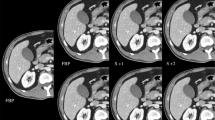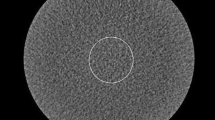Abstract
Background
Iterative reconstruction can be helpful to reduce radiation dose while maintaining image quality. However, this technique has not been fully evaluated in children during abdominal CT.
Objective
To compare objective and subjective image quality between half-dose images reconstructed with iterative reconstruction at iteration strength levels 1 to 5 (half-S1 to half-S5 studies) and full-dose images reconstructed with filtered back projection (full studies) in pediatric abdominal CT.
Materials and methods
Twenty-one children (M:F = 13:8; mean age 8.2 ± 5.7 years) underwent dual-source abdominal CT (mean effective dose 4.8 ± 2.1 mSv). The objective image quality was evaluated as noise. Subjective image quality analysis was performed comparing each half study to the full study for noise, sharpness, artifact and diagnostic acceptability.
Results
Both objective and subjective image noise decreased with increasing iteration strength. Half-S4 and -S5 studies showed objective image noise similar to or lower than that of full studies. The half-S2 and -S3 studies produced the greatest sharpness and the half-S5 studies were the worst from a blocky appearance. Full and half studies did not differ in artifacts. Half-S3 studies showed the best diagnostic acceptability.
Conclusion
Half-S4 and -S5 studies objectively and half-S3 studies subjectively showed comparable image quality to full studies in pediatric abdominal CT.

Similar content being viewed by others
References
Pearce MS, Salotti JA, Little MP et al (2012) Radiation exposure from CT scans in childhood and subsequent risk of leukaemia and brain tumours: a retrospective cohort study. Lancet 380:499–505
Mathews JD, Forsythe AV, Brady Z et al (2013) Cancer risk in 680,000 people exposed to computed tomography scans in childhood or adolescence: data linkage study of 11 million Australians. Br Med J 346:f2360
Kalra MK, Maher MM, D’Souza RV et al (2005) Detection of urinary tract stones at low-radiation-dose CT with z-axis automatic tube current modulation: phantom and clinical studies. Radiology 235:523–529
Brenner DJ, Hall EJ (2007) Computed tomography — an increasing source of radiation exposure. N Engl J Med 357:2277–2284
Vorona GA, Ceschin RC, Clayton BL et al (2011) Reducing abdominal CT radiation dose with the adaptive statistical iterative reconstruction technique in children: a feasibility study. Pediatr Radiol 41:1174–1182
Ziegler A, Kohler T, Proksa R (2007) Noise and resolution in images reconstructed with FBP and OSC algorithms for CT. Med Phys 34:585–598
Hara AK, Paden RG, Silva AC et al (2009) Iterative reconstruction technique for reducing body radiation dose at CT: feasibility study. AJR Am J Roentgenol 193:764–771
Marin D, Nelson RC, Schindera ST et al (2010) Low-tube-voltage, high-tube-current multidetector abdominal CT: improved image quality and decreased radiation dose with adaptive statistical iterative reconstruction algorithm — initial clinical experience. Radiology 254:145–153
Moscariello A, Takx RA, Schoepf UJ et al (2011) Coronary CT angiography: image quality, diagnostic accuracy, and potential for radiation dose reduction using a novel iterative image reconstruction technique-comparison with traditional filtered back projection. Eur Radiol 21:2130–2138
Kalra MK, Woisetschlager M, Dahlstrom N et al (2012) Radiation dose reduction with sinogram affirmed iterative reconstruction technique for abdominal computed tomography. J Comput Assist Tomogr 36:339–346
Nelson RC, Feuerlein S, Boll DT (2011) New iterative reconstruction techniques for cardiovascular computed tomography: how do they work, and what are the advantages and disadvantages? J Cardiovasc Comput Tomogr 5:286–292
Mieville FA, Gudinchet F, Brunelle F et al (2013) Iterative reconstruction methods in two different MDCT scanners: physical metrics and 4-alternative forced-choice detectability experiments — a phantom approach. Phys Med 29:99–110
Lee SH, Kim MJ, Yoon CS et al (2012) Radiation dose reduction with the adaptive statistical iterative reconstruction (ASIR) technique for chest CT in children: an intra-individual comparison. Eur J Radiol 81:e938–943
Mieville FA, Berteloot L, Grandjean A et al (2013) Model-based iterative reconstruction in pediatric chest CT: assessment of image quality in a prospective study of children with cystic fibrosis. Pediatr Radiol 43:558–567
Mieville FA, Gudinchet F, Rizzo E et al (2011) Paediatric cardiac CT examinations: impact of the iterative reconstruction method ASIR on image quality — preliminary findings. Pediatr Radiol 41:1154–1164
Fletcher JG, Grant KL, Fidler JL et al (2012) Validation of dual-source single-tube reconstruction as a method to obtain half-dose images to evaluate radiation dose and noise reduction: phantom and human assessment using CT colonography and sinogram-affirmed iterative reconstruction (SAFIRE). J Comput Assist Tomogr 36:560–569
Baker ME, Dong F, Primak A et al (2012) Contrast-to-noise ratio and low-contrast object resolution on full- and low-dose MDCT: SAFIRE versus filtered back projection in a low-contrast object phantom and in the liver. AJR Am J Roentgenol 199:8–18
Fletcher JG, Krueger WR, Hough DM et al (2013) Pilot study of detection, radiologist confidence and image quality with sinogram-affirmed iterative reconstruction at half-routine dose level. J Comput Assist Tomogr 37:203–211
Han BK, Grant KL, Garberich R et al (2012) Assessment of an iterative reconstruction algorithm (SAFIRE) on image quality in pediatric cardiac CT datasets. J Cardiovasc Comput Tomogr 6:200–204
Winklehner A, Goetti R, Baumueller S et al (2011) Automated attenuation-based tube potential selection for thoracoabdominal computed tomography angiography: improved dose effectiveness. Invest Radiol 46:767–773
Boone J, Strauss K, Cody D et al (2011) AAPM report No. 204: size-specific dose estimates (SSDE) in pediatric and adult body CT examinations. American Association of Physicists in Medicine. http://www.aapm.org/pubs/reports/rpt_204.pdf. Accessed 31 May 2014
McCollough C, Cody D, Edyvean S et al (2008) AAPM report No. 96: the measurement, reporting and management of radiation dose in CT. American Association of Physicists in Medicine. http://www.aapm.org/pubs/reports/rpt_96.pdf. Accessed 31 May 2014
Flohr TG, McCollough CH, Bruder H et al (2006) First performance evaluation of a dual-source CT (DSCT) system. Eur Radiol 16:256–268
McCollough CH, Primak AN, Saba O et al (2007) Dose performance of a 64-channel dual-source CT scanner. Radiology 243:775–784
Singh S, Kalra MK, Shenoy-Bhangle AS et al (2012) Radiation dose reduction with hybrid iterative reconstruction for pediatric CT. Radiology 263:537–546
Smith EA, Dillman JR, Goodsitt MM et al (2014) Model-based iterative reconstruction: effect on patient radiation dose and image quality in pediatric body CT. Radiology 270:526–534
Tricarico F, Hlavacek AM, Schoepf UJ et al (2013) Cardiovascular CT angiography in neonates and children: image quality and potential for radiation dose reduction with iterative image reconstruction techniques. Eur Radiol 23:1306–1315
Conflicts of interest
None
Author information
Authors and Affiliations
Corresponding author
Rights and permissions
About this article
Cite this article
Lee, M., Kim, MJ., Han, K.H. et al. Half-dose abdominal CT with sinogram-affirmed iterative reconstruction technique in children — comparison with full-dose CT with filtered back projection. Pediatr Radiol 45, 188–193 (2015). https://doi.org/10.1007/s00247-014-3105-y
Received:
Revised:
Accepted:
Published:
Issue Date:
DOI: https://doi.org/10.1007/s00247-014-3105-y




